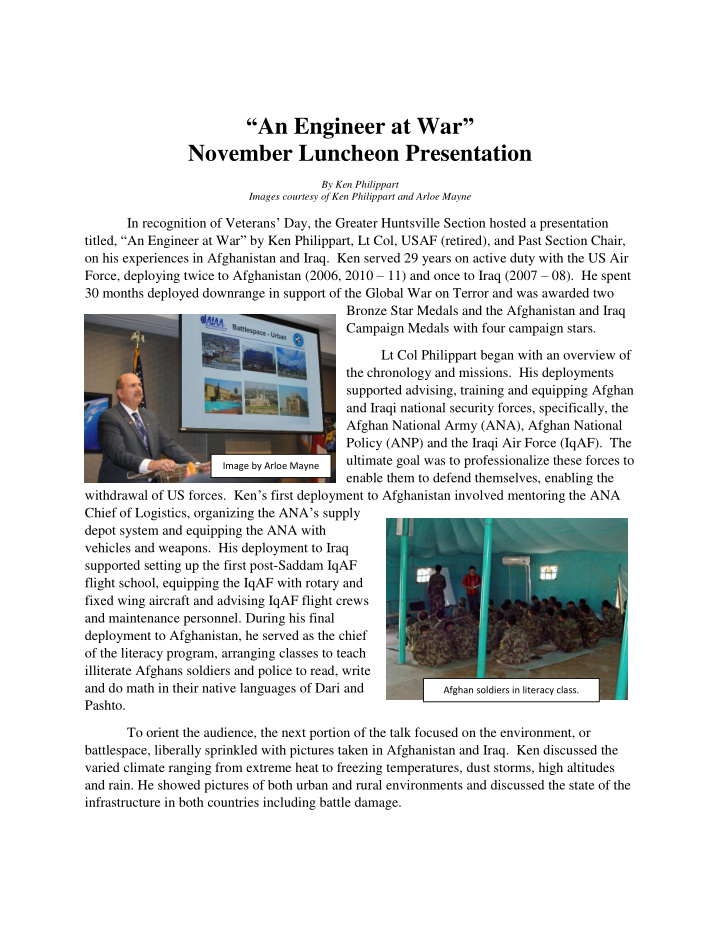



“ An Engineer at War ” November Luncheon Presentation By Ken Philippart Images courtesy of Ken Philippart and Arloe Mayne In recognition of Veterans ’ Day, the Greater Huntsville Section hosted a presentation titled, “ An Engineer at War ” by Ken Philippart, Lt Col, USAF (retired), and Past Section Chair, on his experiences in Afghanistan and Iraq. Ken served 29 years on active duty with the US Air Force, deploying twice to Afghanistan (2006, 2010 – 11) and once to Iraq (2007 – 08). He spent 30 months deployed downrange in support of the Global War on Terror and was awarded two Bronze Star Medals and the Afghanistan and Iraq Campaign Medals with four campaign stars. Lt Col Philippart began with an overview of the chronology and missions. His deployments supported advising, training and equipping Afghan and Iraqi national security forces, specifically, the Afghan National Army (ANA), Afghan National Policy (ANP) and the Iraqi Air Force (IqAF). The ultimate goal was to professionalize these forces to Image by Arloe Mayne enable them to defend themselves, enabling the withdrawal of US forces. Ken ’ s first deployment to Afghanistan involved mentoring the ANA Chief of Logistics, organizing the ANA ’ s supply depot system and equipping the ANA with vehicles and weapons. His deployment to Iraq supported setting up the first post-Saddam IqAF flight school, equipping the IqAF with rotary and fixed wing aircraft and advising IqAF flight crews and maintenance personnel. During his final deployment to Afghanistan, he served as the chief of the literacy program, arranging classes to teach illiterate Afghans soldiers and police to read, write and do math in their native languages of Dari and Afghan soldiers in literacy class. Pashto. To orient the audience, the next portion of the talk focused on the environment, or battlespace, liberally sprinkled with pictures taken in Afghanistan and Iraq. Ken discussed the varied climate ranging from extreme heat to freezing temperatures, dust storms, high altitudes and rain. He showed pictures of both urban and rural environments and discussed the state of the infrastructure in both countries including battle damage.
The presentation next focused on Afghan and Iraqi culture including the long history of both countries, the central role of Islam, evolving gender roles, attitudes toward children, and the very different perspectives on safety. Ken then spoke briefly about military camp life such as accommodations, meals, local markets and entertainment including a USO tour by Apollo astronauts Neil Armstrong, Jim Lovell and Gene Cernan. He followed this by explaining the threats to US personnel such as improvised explosive devices, rockets, mortars, Lt Col Philippart in front of unexploded Bala Hissar Fortress in Kabul Baghdad ’ s Swords of Victory ordnance and “ green on blue ” attacks. A brief illustration of modes of travel within Iraq and Afghanistan concluded the background portion of the presentation. Ken then presented images of humorous signs and assorted exotic aircraft he saw while deployed before launching into the engineering observations portion of the talk. He explained that while none of his deployments were engineering-specific, he did learn several lessons relevant to engineering. He categorized these lessons as: engineers see things differently (and that’s a good thing) ; understanding how non-American perspectives can affect engineering; and how operational experience improves requirements engineering. His first point was that those with an engineering background see things differently in being able to methodically assess the causes of problems and propose solutions. He illustrated this with a discussion about attempts to use computer based training in Afghanistan for basic literacy education and how engineers immediately recognized the drawbacks of this approach. He also discussed the first application of earned value management to literacy training, by an engineer, and how it helped reveal areas of concern. The second major lesson learned was to understand non-American perspectives and how these can affect engineering problems. He explained how engineers are esteemed in Afghanistan especially, with the title “ Engineer ” being used much like “ Doctor ” is used in the US. He illustrated the effect of non-American perspectives through four real-world examples during his deployments: the outfitting of a Mi-17 helicopter with a door gun, equipping the ANA with AK-47 small arms, training IqAF pilots and an aviation accident and investigation. Finally, he explained how he learned that having operational experience helps better understand operational requirements and leads to superior engineering solutions. He supported
this lesson with several examples including the use of cell phones versus hand held radios, the adoption of up-armored non-tactical vehicles for routine transportation, indirect fire defenses and better test simulation of deployed defenses back home. Ken also brought several items to illustrate his talk including the flags of Afghanistan and Iraq, a “ blood chit, ” and an Afghan burka, pakol and war rug. Lt Col Philippart ended his talk with a listing of names of US Air Force personnel who paid the ultimate price during his deployments and asked the audience to never forget their sacrifices. Philippart with Afghan war rug (image by Arloe Mayne)
Recommend
More recommend